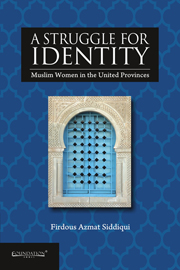Book contents
- Frontmatter
- Contents
- Acknowledgements
- Introduction
- 1 Social Stratification of Muslim Women in the United Provinces
- 2 Socio-religious Movement and the Muslim Women's Issue
- 3 British Perception of Muslim Women: Questions of Fecundity and Health
- 4 Crises in the Social and Economic Identity of Muslim Women: The Great Uprising of 1857
- 5 Changing Profile of Muslim Women through Education
- 6 Patriarchy and Social Obligation of Indian Muslim Women
- 7 Cultural Clash: From Tawaif to Kasbi
- 8 Law, Land and Muslim Women: The Economic Situation
- 9 Muslim Women's Response to the New Judicial System
- Conclusion
- Glossary
- Bibliography
- Index
2 - Socio-religious Movement and the Muslim Women's Issue
Published online by Cambridge University Press: 05 October 2014
- Frontmatter
- Contents
- Acknowledgements
- Introduction
- 1 Social Stratification of Muslim Women in the United Provinces
- 2 Socio-religious Movement and the Muslim Women's Issue
- 3 British Perception of Muslim Women: Questions of Fecundity and Health
- 4 Crises in the Social and Economic Identity of Muslim Women: The Great Uprising of 1857
- 5 Changing Profile of Muslim Women through Education
- 6 Patriarchy and Social Obligation of Indian Muslim Women
- 7 Cultural Clash: From Tawaif to Kasbi
- 8 Law, Land and Muslim Women: The Economic Situation
- 9 Muslim Women's Response to the New Judicial System
- Conclusion
- Glossary
- Bibliography
- Index
Summary
After the revolt of 1857, Indian Muslims lost the privileges they had enjoyed for a long time. Their role in the revolt meant that Muslim losses in terms of power and privileges were greater than those suffered by other communities. Unlike the Hindus, they began to feel increasingly distanced from the mainstream, and could not come to terms with their continuously deteriorating condition. Holding the British responsible for their miseries, an alienation of sorts from the Western way of life set in, to the extent that even English education was considered profane. Maulvi Nazir revealed his father's hostility towards English education thus: ‘He would rather see me die than learn English’. Men sought to safeguard their religion, culture and caste by confining their females within their homes. As a result, they began lagging behind in the race for progress.
The uprising of 1857 seemed to have awakened Muslims from a long slumber. Fortunately, they found an outspoken leader in Sir Saiyid Ahmed Khan (1817–98), who was born in a leading Saiyid family of Delhi, and whose ancestors had served the Mughal court for generations. Sir Saiyid was the first Muslim to question every aspect of life in Muslim society, and highlight how their ignorance was leading to the deteriorating condition.
- Type
- Chapter
- Information
- A Struggle for IdentityMuslim Women in United Provinces, pp. 18 - 34Publisher: Foundation BooksPrint publication year: 2014



